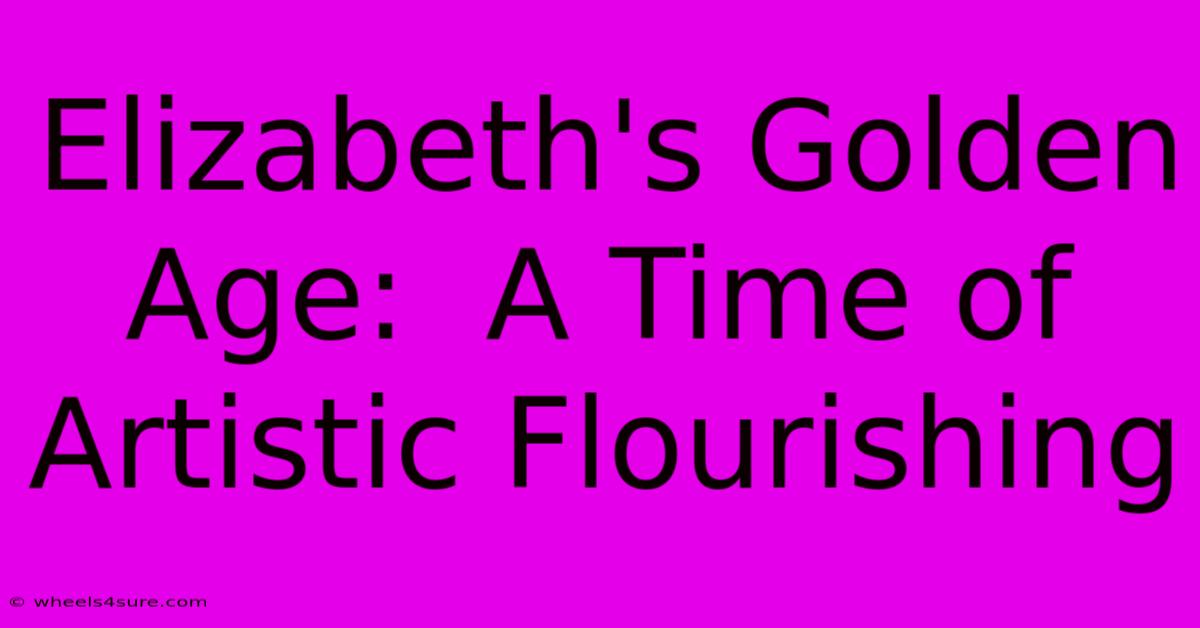Elizabeth's Golden Age: A Time Of Artistic Flourishing

Table of Contents
Elizabeth's Golden Age: A Time of Artistic Flourishing
England's Elizabethan era, spanning the reign of Queen Elizabeth I (1558-1603), is widely celebrated as a "Golden Age." This wasn't just a period of political stability and burgeoning exploration; it was a time of unparalleled artistic flourishing across various mediums. From the majestic grandeur of Elizabethan architecture to the soaring heights of Shakespearean drama, this period left an indelible mark on English and, indeed, world culture. This article will delve into the key factors contributing to this artistic explosion and explore some of its most significant achievements.
The Patronage System: Fueling Artistic Innovation
One of the most crucial factors driving the artistic boom was the elaborate patronage system. Queen Elizabeth herself was a significant patron, commissioning portraits, music, and literature. However, patronage extended far beyond the royal court. Wealthy nobles, merchants, and even the rising middle class competed to support artists, musicians, and writers, fostering a vibrant and competitive creative environment. This system provided artists with the financial security necessary to dedicate themselves to their craft, leading to a remarkable increase in both quantity and quality of artistic output. Think of it as a kind of early venture capital for the arts!
The Impact of Royal Favor
The Queen's own taste and preferences significantly influenced artistic trends. Her image, carefully cultivated through portraiture, projected an aura of power, intelligence, and magnificence. Artists like Nicholas Hilliard perfected the miniature portrait, capturing the subtle nuances of her expression and emphasizing her regal status. This royal patronage not only supported individual artists but also established a stylistic standard that permeated other artistic forms.
Shakespeare and the Rise of English Drama
No discussion of the Elizabethan Golden Age is complete without mentioning William Shakespeare. His plays, performed at the Globe Theatre and other venues, captured the spirit of the age with their profound exploration of human nature, political intrigue, and historical events. Shakespeare's mastery of language and his creation of iconic characters elevated English drama to unprecedented heights. His works continue to be performed and studied globally, a testament to their enduring power and relevance.
Beyond Shakespeare: A Diverse Theatrical Landscape
While Shakespeare undoubtedly dominated the theatrical landscape, he wasn't alone. Other playwrights, such as Christopher Marlowe, Ben Jonson, and Thomas Dekker, contributed significantly to the richness and diversity of Elizabethan drama. The period saw the development of distinct dramatic genres, from tragicomedy to history plays, reflecting the complexity and dynamism of Elizabethan society. The rise of professional acting companies and the construction of purpose-built theaters also contributed to the flourishing of this art form.
Architectural Marvels: Reflecting Power and Prosperity
The architectural achievements of the Elizabethan era are equally impressive. Elaborate manor houses, stately homes, and grand country estates reflect the wealth and power of the aristocracy. The characteristic style, often described as "Elizabethan," incorporated elements of both Tudor and classical influences, resulting in buildings that were both imposing and aesthetically pleasing. Think magnificent castles, intricate detailing, and soaring chimneys – symbols of prosperity and a nation on the rise.
The Influence of Renaissance Ideas
The Renaissance, with its emphasis on classical learning and artistic innovation, deeply influenced Elizabethan architecture. The incorporation of classical motifs, symmetry, and proportion reflected a broader intellectual and cultural shift towards humanism and a renewed appreciation for ancient Greek and Roman art.
Music and the Madrigal Tradition
The Elizabethan era also witnessed a golden age of music. The madrigal, a genre of polyphonic vocal music, enjoyed immense popularity. Composers like William Byrd and Thomas Tallis created intricate and expressive madrigals, showcasing the technical virtuosity of both composers and performers. Music played a vital role in courtly life and was increasingly incorporated into theatrical productions, further enriching the cultural tapestry of the time.
Conclusion: A Legacy of Artistic Excellence
Elizabeth's Golden Age stands as a testament to the power of patronage, creativity, and cultural exchange. The artistic achievements of this period continue to inspire and influence artists and audiences worldwide. From Shakespeare's timeless plays to the architectural splendor of Elizabethan buildings, the legacy of this era remains vibrant and profoundly impactful. The era’s remarkable artistic flourishing was not just a matter of chance; it was the result of a complex interplay of social, political, and economic factors that combined to create a truly exceptional moment in English history. The influence of Elizabeth's Golden Age can still be felt today, a lasting testament to its enduring legacy.

Thank you for visiting our website wich cover about Elizabeth's Golden Age: A Time Of Artistic Flourishing. We hope the information provided has been useful to you. Feel free to contact us if you have any questions or need further assistance. See you next time and dont miss to bookmark.
Featured Posts
-
Zahide Age Never Giving Up On Your Dreams
Apr 02, 2025
-
Robert Herjavecs Net Worth Achieving Your Dreams
Apr 02, 2025
-
The Astonishing Net Worth Of Dolly Chaiwala How He Did It
Apr 02, 2025
-
Salman Khan Age Beyond The Numbers
Apr 02, 2025
-
Boost Your Reproductive Health Tips And Advice For Men
Apr 02, 2025
